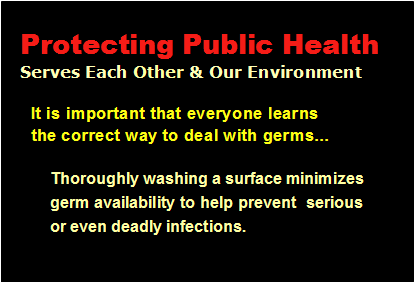
Our Lives Depend on Good Public Health Practices
Inaccurate information
implying that a disinfectant-detergent solution removes all of the soil
and "kills" 100% of the germs
in the soil on the surface being washed fosters
a false security. To assume
that such surfaces
are
germ-free
and
infection-proof
may
end
as a deadly mistake.
Housekeeping/custodial
managers and salespeople often declare that "the government says
disinfectant-detergents must be used" for washing everything from
toilets to food carts... Please investigate the facts before you
accept anything as an "official" government
mandate.
The true facts may
shock you: EPA-registered
product labels
state
(government
law)
that whenever using
a disinfectant-detergent solution, it must be applied to
a
clean
(sanitary)
surface—soil
contaminates the disinfectant and renders it ineffective. To
worsen matters, germs that survived
the
disinfectant
are
now
resistant to it and will forever propagate as more dangerous
disinfectant-resistant super germs.
All surfaces - operating table or toilet - must be washed
free of soil before a disinfectant solution can be applied.
Only
the first surface user benefits
from each disinfectant treatment.
Subsequent users will be using a surface occupied by
disinfectant-resistant super germs.
EPA requires a disinfectant
solutions to be applied to a clean surface. A treated surface
needs to be washed and rinsed well after each use—the
sooner the better.
Contaminated soil left on a surface becomes a farm for disinfectant-resistant super germs
fostering
dangerous contact
infections or a launching pad for airborne germ spores that can cause
lethal bronchial infections or incite asthmatic and/or allergic
reactions.
Bottom Line: Surfaces that do not get
washed after each use should be washed well on an as-needed
bases using a general detergent. Surfaces that do get
washed and retreated after each use should be washed with a
general detergent solution, rinsed well, and then treated.
A
clean surface is a sanitary surface.